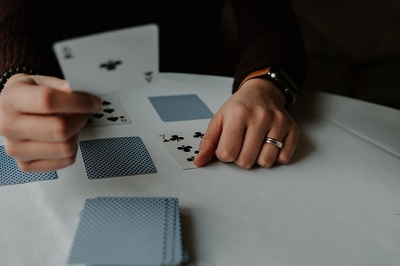
Close-up magic is a fascinating form of entertainment that has been capturing the hearts and minds of audiences for centuries.
In this post, we will explore the art of close-up magic, including what it is, how it works, its history, and techniques!
What is Close-Up Magic?
Close-up magic is a type of magic performance that is designed to be performed up close and personal, often right in front of the spectator’s eyes. It is a style of magic that relies on sleight of hand, misdirection, and psychology to create the illusion of impossible feats.
Close-up magic is typically performed in a variety of settings, such as at a restaurant, bar, or private party. The magician will often use everyday objects, such as coins, cards, and other small props, to create the illusion of magic. The performer will often perform with minimal setup or props and rely on their skill as a magician to create the illusion.

The goal of close-up magic is to create a sense of intimacy and wonder between the performer and the audience. Unlike stage magic, where the audience is often seated at a distance from the performer, close-up magic allows the audience to be up close and personal with the magician, creating a more intimate and engaging experience.
How Does Close-Up Magic Work?
Close-up magicians use a variety of techniques to create the illusion of magic. One of the most important techniques is sleight of hand, which involves manipulating objects with subtle hand movements to create the illusion of impossible feats.
This may include techniques such as palming, which involves hiding an object in the hand; false shuffles, which create the illusion of randomness while keeping the cards in a specific order; and forcing, which involves influencing a spectator’s choice without them realizing it. (See also Card Sleight of Hand Basics)
Misdirection is also a key technique used in close-up magic. Misdirection involves directing the audience’s attention away from the secret maneuver being performed by the magician. This may include using a distracting movement or gesture, or creating a diversion to draw the audience’s attention away from the action.
Another tool of close-up magicians are certain gimmicks and tools, such as a magic deck of cards, or trick decks (as well as other items such as trick coins). These gimmicks look like ordinary objects, but are customized in a way that allows the magician to perform something secret, which is usually not possible if the object were an ordinary ungimmicked object.
Magicians will also use many different ungimmicked props in close-up tricks, not being gimmicked or having a secret to them, but just necessary for the trick. This includes sponge balls, rope, cups and balls, rings, dice, scarves, and more. These allow the perform to perform many different illusions beyond just card tricks.

In addition to sleight of hand and misdirection, close-up magicians also rely on psychology to create the illusion of magic. They use techniques such as suggestion, persuasion, and influence to create a sense of wonder and amazement in the audience.
This may include techniques such as suggestion, where the magician plants an idea in the spectator’s mind without them realizing it; or influence, where the magician creates a situation where the spectator feels compelled to do something.
(Learn more at How Does Close-Up Magic Work?)
History of Close-Up Magic
Close-up magic has a long and storied history, with roots dating back to ancient times. In ancient Egypt, for example, magicians would perform close-up magic tricks using coins and other small objects. In medieval times, street performers would perform close-up magic for small groups of spectators, often using props such as cups and balls to create the illusion of magic.
The modern era of close-up magic began in the early 20th century, with the rise of famous magicians such as Houdini and Dai Vernon. These magicians were known for their skill at sleight of hand and their ability to create the illusion of magic using everyday objects. (See also Greatest Close-Up Magicians of All Time)
Today, close-up magic remains a popular form of entertainment around the world. Magicians such as David Blaine, Penn & Teller, and Dynamo have all achieved international fame for their skill at close-up magic. Close-up magic is also a popular form of entertainment at corporate events, weddings, and private parties.
Final Thoughts
In conclusion, close-up magic is a unique form of magic that relies on skill, misdirection, and psychology to create the illusion of magic. Close-up magicians use a variety of techniques, such as sleight of hand and misdirection, to create the illusion of impossible feats.
Close-up magic has a long and storied history, dating back to ancient times, and continues to be a popular form of entertainment today. If you have never experienced close-up magic, it is an unforgettable experience that is sure to leave you amazed and wondering how it was done.
The magician started magic as a kid and has learned from some of the greats. He loves to share his knowledge with others and help out with the subtleties he’s learned along the way.
Follow on YouTube at the link below to get free tricks and advice!


